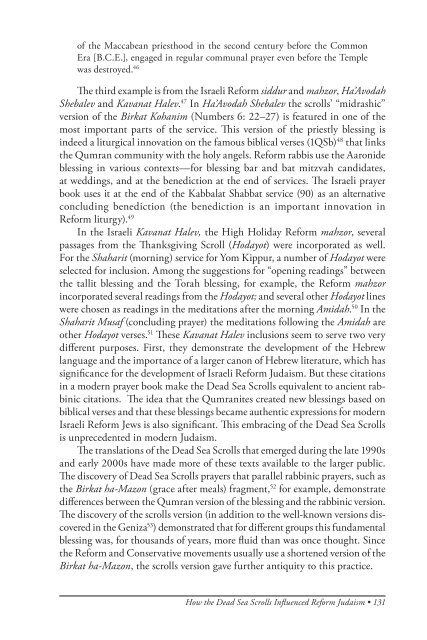The American Jewish Archives Journal, Volume LXI 2009, Number 1
The American Jewish Archives Journal, Volume LXI 2009, Number 1
The American Jewish Archives Journal, Volume LXI 2009, Number 1
Create successful ePaper yourself
Turn your PDF publications into a flip-book with our unique Google optimized e-Paper software.
of the Maccabean priesthood in the second century before the Common<br />
Era [B.C.E.], engaged in regular communal prayer even before the Temple<br />
was destroyed. 46<br />
<strong>The</strong> third example is from the Israeli Reform siddur and mahzor, Ha’Avodah<br />
Shebalev and Kavanat Halev. 47 In Ha’Avodah Shebalev the scrolls’ “midrashic”<br />
version of the Birkat Kohanim (<strong>Number</strong>s 6: 22–27) is featured in one of the<br />
most important parts of the service. This version of the priestly blessing is<br />
indeed a liturgical innovation on the famous biblical verses (1QSb) 48 that links<br />
the Qumran community with the holy angels. Reform rabbis use the Aaronide<br />
blessing in various contexts—for blessing bar and bat mitzvah candidates,<br />
at weddings, and at the benediction at the end of services. <strong>The</strong> Israeli prayer<br />
book uses it at the end of the Kabbalat Shabbat service (90) as an alternative<br />
concluding benediction (the benediction is an important innovation in<br />
Reform liturgy). 49<br />
In the Israeli Kavanat Halev, the High Holiday Reform mahzor, several<br />
passages from the Thanksgiving Scroll (Hodayot) were incorporated as well.<br />
For the Shaharit (morning) service for Yom Kippur, a number of Hodayot were<br />
selected for inclusion. Among the suggestions for “opening readings” between<br />
the tallit blessing and the Torah blessing, for example, the Reform mahzor<br />
incorporated several readings from the Hodayot; and several other Hodayot lines<br />
were chosen as readings in the meditations after the morning Amidah. 50 In the<br />
Shaharit Musaf (concluding prayer) the meditations following the Amidah are<br />
other Hodayot verses. 51 <strong>The</strong>se Kavanat Halev inclusions seem to serve two very<br />
different purposes. First, they demonstrate the development of the Hebrew<br />
language and the importance of a larger canon of Hebrew literature, which has<br />
significance for the development of Israeli Reform Judaism. But these citations<br />
in a modern prayer book make the Dead Sea Scrolls equivalent to ancient rabbinic<br />
citations. <strong>The</strong> idea that the Qumranites created new blessings based on<br />
biblical verses and that these blessings became authentic expressions for modern<br />
Israeli Reform Jews is also significant. This embracing of the Dead Sea Scrolls<br />
is unprecedented in modern Judaism.<br />
<strong>The</strong> translations of the Dead Sea Scrolls that emerged during the late 1990s<br />
and early 2000s have made more of these texts available to the larger public.<br />
<strong>The</strong> discovery of Dead Sea Scrolls prayers that parallel rabbinic prayers, such as<br />
the Birkat ha-Mazon (grace after meals) fragment, 52 for example, demonstrate<br />
differences between the Qumran version of the blessing and the rabbinic version.<br />
<strong>The</strong> discovery of the scrolls version (in addition to the well-known versions discovered<br />
in the Geniza 53 ) demonstrated that for different groups this fundamental<br />
blessing was, for thousands of years, more fluid than was once thought. Since<br />
the Reform and Conservative movements usually use a shortened version of the<br />
Birkat ha-Mazon, the scrolls version gave further antiquity to this practice.<br />
How the Dead Sea Scrolls Influenced Reform Judaism • 131

















